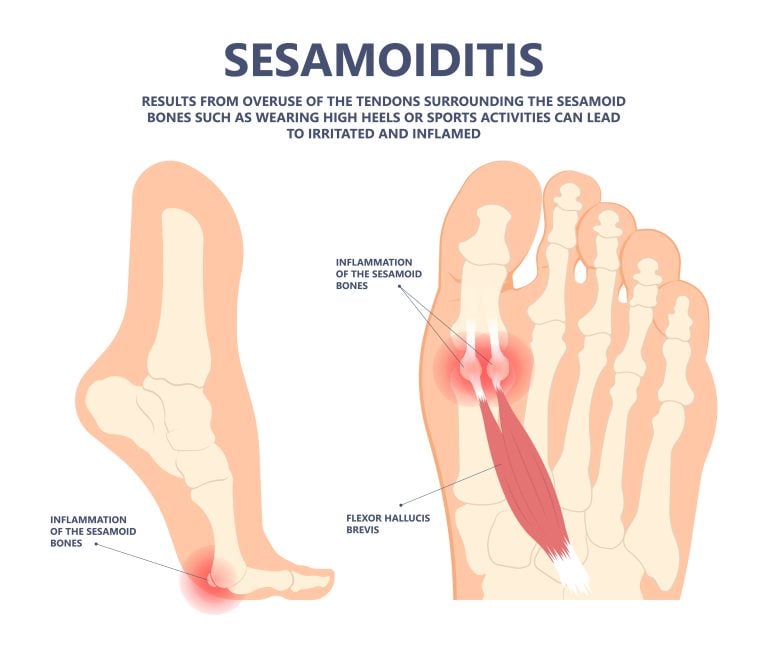Sesamoiditis: What Is It, Symptoms, Causes & Podiatry Treatments
Sesamoiditis, a condition commonly seen in athletes and dancers, involves the inflammation of tendons connected to the sesamoid bones, which are small structures embedded within tendons in the foot.
Sesamoiditis can manifest as persistent pain under the ball of the foot, coupled with swelling and tenderness, potentially hindering mobility of the big toe. Understanding its causes, which include overuse and biomechanical issues, is vital for effective management.
With various sesamoiditis treatment options available, such as the RICE protocol and custom orthotics, the role of podiatry becomes indispensable. But what precisely causes this crippling condition, and how can we manage sesamoiditis effectively?
Understanding Sesamoiditis
Understanding sesamoiditis requires an examination of the chronic inflammation affecting the tendons attached to the sesamoid bones, typically triggered by overuse and repetitive stress.
Sesamoiditis mainly afflicts athletes, dancers, and individuals whose foot biomechanics predispose them to increased pressure on the sesamoid bones, located beneath the big toe. Chronic inflammation in sesamoiditis manifests as a persistent aching pain localised under the ball of the foot, exacerbated by movement and direct pressure.

Causes of Sesamoiditis
Sesamoiditis is primarily caused by overuse and repetitive stress, particularly in activities like running, ballet, and basketball, which place excessive pressure on the sesamoid bones beneath the big toe.
Sesamoiditis frequently manifests as pain under the big toe pad, which worsens with continued activity:
Athletes and dancers are especially susceptible to sesamoiditis due to the high impact and stress endured by their feet during training and performances.
Individuals with high arches or those consistently wearing high-heeled shoes are at an elevated risk of developing sesamoiditis.
The increased load on the sesamoid bone foot structure can lead to microtrauma, resulting in sesamoiditis inflammation and pain in the pad of the foot under the big toe.
Direct trauma, such as fractures or severe bruising to the sesamoid bones, can also precipitate sesamoiditis.
The sesamoid bones play a critical role in the foot’s biomechanical function, particularly in the pulley system that facilitates toe movement. Disruption of this system can lead to significant sesamoiditis foot pain in the ball of the foot and big toe.
Additionally, when the tendon in the big toe hurts due to overuse or injury, it further exacerbates the symptoms of sesamoiditis, necessitating prompt and effective treatment.
Symptoms to Watch For
Patients presenting with sesamoiditis often report some or all of the following symptoms:
The patient experiences a persistent dull, aching pain that is localised beneath the big toe joint. Specific movements, such as toe flexion and extension, or certain types of footwear that place pressure on the forefoot typically exacerbate this sesamoiditis discomfort.
Clinical observations frequently indicate localised swelling and tenderness in the ball of the foot, which may extend to visible bruising in more severe cases.
Individuals may also experience difficulty moving the big toe, contributing to alterations in their gait and overall mobility.
This restricted range of motion can be particularly pronounced during high-impact activities, including running, jumping, or activities that require frequent pivoting, such as dancing.
Moreover, patients may experience more pain when bending or straightening their toes, underscoring the mechanical stress these motions place on the sesamoid bones.
Recognising these sesamoiditis symptoms early is essential for prompt intervention, as prolonged stress on the sesamoid bones without adequate treatment can lead to chronic pain and functional impairment of the foot.
Podiatry Treatments
Implementing a thorough podiatry treatment plan for sesamoiditis involves a multi-faceted approach to mitigate pain and promote healing:
Initial management typically adheres to the RICE protocol—rest, ice, compression, and elevation—to alleviate acute sesamoiditis inflammation and discomfort.
The application of nonsteroidal anti-inflammatory drugs (NSAIDs) can further assist in reducing pain and swelling.
Podiatrists frequently prescribe custom orthotic devices or strategically placed padding to redistribute pressure away from the sesamoid bones during ambulation, thereby minimising stress on the affected area.
Physical therapy is integral, encompassing targeted exercises designed to stretch and fortify the surrounding musculature and tendons, thereby enhancing joint functionality and reducing symptom recurrence.
When conservative measures fail to alleviate pain, podiatrists may recommend that doctors administer corticosteroid injections to specifically reduce sesamoiditis inflammation.
Surgical intervention may be considered in cases of refractory sesamoiditis. Sesamoidectomy procedures, reserved for severe cases, involve partial or complete removal of the sesamoid bone to alleviate pain and restore mobility.
Prevention Tips
To prevent sesamoiditis, it is essential to adopt practical measures that minimise stress on the sesamoid bones.
Wearing shoes with a wide toe box is critical; this design reduces pressure on the metatarsophalangeal joint and the sesamoid apparatus. Ensuring proper footwear selection and regularly replacing worn-out shoes can provide the necessary cushioning and structural support to mitigate repetitive stress injuries.
We highly recommend orthotic devices tailored to individual biomechanical needs during high-impact activities. These devices can redistribute load away from the sesamoid bones, thereby preventing excessive strain. Consulting a knowledgeable podiatrist for personalised orthotic recommendations is imperative to optimise their effectiveness.
Engaging with professional clinics such as Bellevue Podiatry can offer detailed preventive strategies tailored to individual risk factors and activity levels. A systematic approach to foot health, including regular assessments and adjustments to orthotic devices, ensures sustained prevention.

Conclusion
To sum up, sesamoiditis poses a significant challenge to foot health, especially among athletes and dancers.
The sesamoiditis persistent pain, worsened by the most basic movements, highlights the crucial importance of early diagnosis and intervention.
Utilising evidence-based treatments such as the RICE protocol, NSAIDs, and custom orthotic devices can alleviate suffering and prevent sesamoiditis recurrence.
Being diligent with footwear choices and seeking personalised podiatric guidance are essential in preventing this debilitating sesamoiditis condition, thus ensuring peak performance and sustained mobility.
